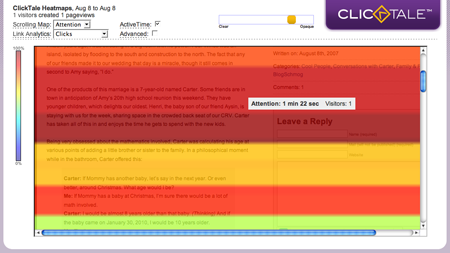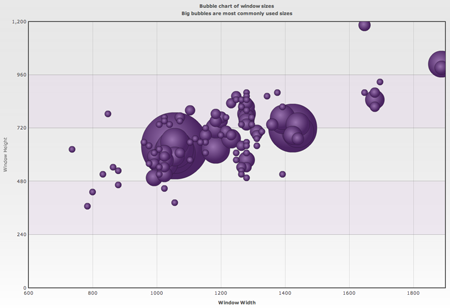When the dust settles on a site redesign this month, I don’t know if ClickTale will make the cut. Cost and page load speed will play a big role in whether we keep their widget installed. Regardless, it seems like a potentially useful tool with plenty of new information you can’t get through standard blog statistics.
After TechCrunch reviewed the service earlier this month, I signed up for the Beta program. ClickTale is now open to the public and worth a try for bloggers interested in exploring how readers make use of a site.
To install ClickTale requires a couple lines of code to wrap the visible page content being studied. Based on the known readership statistics, ClickTale randomly selects reader sessions to record for later analysis. That analysis includes everything from window resizing to tracking of the mouse and scroll movements.

ClickTales tracks reader movement and focus, visualizing this information through a color-coded overlay.
The archives are cumulative, recording “heatmaps” for each page visited. The system doesn’t make intelligent efforts to understand multiple URLs to reach the same page, however, so the results are a bit fragmented (for example, “http://www.blogschmog.net/” and “http://www.blogschmog.net/index.php” are the same web page). A heatmap shows a color-coded transparency over the rendered web page, with hotter colors depicting more time spent in focus in the readers’ browser windows. Entire user sessions are recorded, as well, and available for playback as if you were observing someone manipulate the mouse. This can show how long the visitor took to read the post, if at all.

A bubble chart shows the most popular dimensions of browser windows viewing the blog.
The range of experiential information provided by ClickTales is impressive. The service tracks some traditional metrics, such as reader’s origin (73% U.S. and 21% India for BlogSchmog), platform (split evenly between Mac and PC), and browser (87% use Firefox 2.0). Beyond that, ClickTales tracks the size of the browser window. Knowing what size windows users like allows for optimized designs to take advantage of that preference. Knowing how often the users resize the windows is feeback about whether the site is considered too wide or too small. For example, the current stats tracked this month suggest this site is designed too wide since most users tend to increase the width of their windows before leaving the site.
There is a limited free version of this unique statistical tool, which allows for just 100 recordings per week with stats saved for a month. As a Beta tester, I’m getting the $19/month Personal version, which permits 100 daily recordings saved for two months. The most expensive package is the Professional version. That plan costs $99/month but includes storage space for about 60,000 recordings at a rate of 1000 per day. The Professional version is also the only one that will track HTTPS pages, such as user logins. Traffic surges can be accommodated by purchasing one-time boosts to the number of available recordings.
ClickTale has provided me with some useful insights as we head into a site upgrade. I have a much clearer idea of the kinds of browser experiences people have and how they go about reading the articles. Some of these stats become much less interesting on a daily basis. The detailed recordings and heatmaps are wonderful, but it is a somewhat tedious process to have to wade through each sampled reader rather than be able to see some cumulative evaluation of a new post based on whether people viewed the bottom of the article. My budget definitely doesn’t allow for this to become a paid service for me, but unless analysis this week indicates page loads are significantly suffering, there is also little reason not to at least keep the site sampling 100 sessions each week.